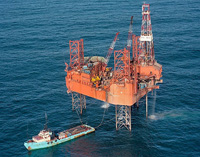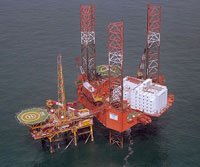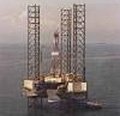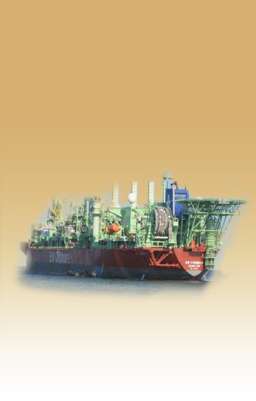Floating Production: 1995 to date
As an independent consultant, assignments under the Peter M Lovie PE, LLC banner have included:-
- Project manager and independent Principal Investigator on behalf of RPSEA for a US Department of Energy funded study on deepwater offloading for US Gulf of Mexico, performed by a five company team in collaboration with ten US operators. Final Report signed 8Oct13, published on 28Mar14 at www.rpsea.org/projects/10121-4407-01
- Assessment of tailend production field acquisition candidates already using an FPSO (an operating oil company);
- Business coach (a software company);
- Advising on entry to FPSO market (two equipment providers);
- Definition of requirements and solicitation of proposals from FPSO contractors for a field development for West Africa, normalizing these proposals to the operator’s needs;
- Other confidential business for multiple investor clients in the offshore arena;
- Chaired and/or presented at 14 industry conferences in Singapore, UK and US: most recent was the Third Annual Emerging FPSO Forum in Galveston on 26 September 2013. As in past two Forums, serves as Chair of Program Committee for the 2014 FPSO Forum in Galveston.
At Devon Energy Corporation Peter was in the Project Support Office, mostly related to the company’s Lower Tertiary business in ultra deepwater developments, for future operated developments and for non-op developments.
- Identified how significant benefits could be secured in the bid process for the first FPSO in GoM, gained management endorsement then partner approval, resulted in a clear dollar saving to the partners in nine figures;
- Identified the need for - and managed - studies on adapting well proven North Sea standards as a policy for (a) shuttle tanker safety for GoM, and (b) simulation of operational uptime in GoM to show practicality and economics;
- Vetted the shuttle tankers contracts and the FPSO lease contract dealings for Cascade/Chinook;
- Throughout the time with Devon, served as Floating Systems advisor on all deepwater teams for GoM: Devon Deepwater Development (3D) which was a Devon internal project, Cascade which was 50:50 Devon with Petrobras as operator, Jack St. Malo (Chevron operated) and Kaskida (BP operated). Participated in related project Decision Analysis workshops as needed.
- Over a two year period, formulated a business model for use of shuttle tankers in GoM for Lower Tertiary developments, applied to Devon’s developments, then for Jack St. Malo (Chevron operated, Devon largest partner after Chevron). Validated the projections through a workshop series held with each of three shuttle tanker providers.
- Developed a methodology for comparing export economics for such developments for (i) pipeline, (ii) shuttle tanker, (iii) storage vessel plus shuttle tanker, (iv) Hiload. Devon approved publishing the methodology at DOT in February 2009 to help stimulate availability of future export options. Projections indicated the potential for ten figure dollar savings over the life of a large Lower Tertiary development. The DOT paper can be found at: www.lovie.org/pdf/125_DOT138_3Feb09.pdf.
- Identified the need for - and managed - two ground breaking studies relating to Lower Tertiary developments: (a) Expandable FPSOs, and (b) Major Revenue Interruption Risks.
- Identified the need for a Marine Safety Policy in Devon for both ongoing overseas operations and the high profile first use of FPSO/shuttle tanker operation in GoM at Cascade.
- Conducted meetings with industry experts and counterparts in supermajors, secured management support for adoption of a Marine Safety Policy for execution by mid 2010.
For American Shuttle Tankers, LLC (later acquired by Teekay) as Vice President of Business Development, Secretary, and Treasurer: devised and executed company’s marketing program to introduce use of shuttle tankers as new transportation alternative in the GoM, moving oil production from remote deepwater platforms to a choice of refineries onshore. Served in business development sector of shuttle tankers and in Teekay Petrojarl Offshore, a new JV with PGS production.
- Led direction of Separate Storage Shuttling (S-S-S), a system jointly developed by Houston and Stavanger affiliate offices—to enable shuttling in the GoM to compete in absence of FPSOs: it employed a dynamically positioned storage vessel and obtained regulatory support.
- Earned product recognition with Meritorious Engineering Award at the Offshore Technology Conference in 2004.
- Applied for patents using technical and U.S. business-method patents, to reinforce company’s business position: served as product inventor for three-patent filings.
- Devising U.S. tanker construction plan with leading offshore fabricator.
- Utilized marketing plan in the GoM to progress business, to earn recognition in the GoM industry as commercially viable key technology—offering serious economic returns on ultra-deep water.
- Represented the company at conferences and on television.
- Pioneered a concept for use of a dynamically positioned Early Production System (EPS) using existing DP tankers for ultra deep water operation, for Chevron and Petrobras operated prospects in GoM.
- Collaborated with a leading GoM operator in a proposal for a deepwater regional hub using a VLCC for storage of oil production from multiple locations in Keathley Canyon.
- Through mounting a multi-year campaign, gained industry acceptance of the principle of using shuttle tankers in GOM in competition with pipelines, changing the question to become one of commercial risk mitigation in the Jones Act market.
For Bluewater as Business Development Manager, North America, held responsibility for developing single point mooring and FPSO business with North America customers, including marketing and contract negotiation. Oversaw technical and commercial dealings for international projects for customers in North America. Identified customers and projects, conducted marketing and sales campaigns, as well as preparing preliminary proposals and conceptual engineering designs.
- Led $400,000,000-bid for generic West African FPSOs, for major oil company applying lessons from internal workshops.
- Managed development and bidding of SPM projects.
- Conducted iterative bid clarification, re-submission, and final negotiation process.
- Devised competitive lease calculations and term trade-offs.
- Created and led internal workshop on project management with 27 managers and specialists, to diagnose and recommend countermeasures for major FPSO construction overruns—affecting company direction and survival.
- Served as activist in Deepstar-led industry EIS initiative, leading to MMS and USCG acceptance of FPSOs in the GoM.
- Acted as company spokesperson at industry meetings and commercial events.
- Proposed FPSOs for deepwater offshore field developments, often in competition with technologies such as TLPs, Spars, and subsea tiebacks.
- Developed and chaired an SPE workshop series in Houston, Texas and Rio de Janeiro, Brazil.
- Visited industry experts, assessed technical requirements, and completed economic projections—for ocean mining.
- Pioneered company’s evaluation of GTL technologies, assembled a consortium of companies for a methanol floating production application offshore Nigeria.
- Investigated new business lines using company’s existing skill sets, including ocean mining, FPDSOs (FPSOs with drilling capability), and use of gas-to-liquids technology on board tankers.
- Created and co-chaired SPE workshop on business lines of possible commercial interest (i.e., latest dealing with stranded gas).
- Responded to requirements for Floating Storage Offshore (FSO) vessels for most parts of the world where of have production of oil has happened or been planned.
- Conducted two year campaign for redeployment of the Glas Dowr FPSO after the fields it was originally on were a bust.
Subsea Processing 1989-1994
At Bardex Subsea Corporation as Vice President of Engineering: Directed engineering and marketing of technologies, presenting to international conferences.
- Organized engineering, technical, financial, and commercial elements of subsea field developments, applying risked economics to clarify trends.
- Presented before oil company and field development contractor customers in Norway, the U.K. and the U.S.
- Set up test and engineering program, as well as developing five-year market projection.
- Negotiated 20-year exclusive, worldwide agreement with Scottish Enterprise in Aberdeen, U.K. for rights to Valved Multiported Connector (VMC).
- Marketed VMC and subsea processing to operators worldwide
For Goodfellow Lovie Associates, as General Manager oversaw bottom-line responsibility for United States operation of a U.K.-based engineering consulting firm.
- Led development of a subsea processing system for Gulf of Mexico in a JIP with four oil companies: Chevron, Marathon, Oryx and Unocal and reported in an OTC paper in 1993
- Led a JIP on gas utilization for three operating oil companies (Chevron, Unocal & Marathon)
Offshore Drilling - 1967-1988
For Lovie and Company as Senior Consultant: Served as expert witness in several major rig loss cases, e.g. for Chevron on loss of the Key Biscayne jackup off the north west coast of Australia in a region known for its being a graveyard for ships over the last four centuries. This multiyear lawsuit against P&O Shipping settled in Chevron’s favor just before trial.
- Represented foreign shipyards and engineering firms in the U.S.
- Negotiated construction contracts and international technical licensing agreements.
- Marketing assessments for new products,
- Troubleshooting consultant for a bank on offshore projects, e.g. finding a basis for projecting if there was any future for a turnkey drilling venture started in offshore Brazil;
- Post 1982, adapted to the energy depression by performing troubleshooting engineering,and marketing assignments for domestic and international clients.
- During 1976-1981 successfully marketed and negotiated numerous construction contracts for Mobile Offshore Drilling Units with Houston drilling contractors on a no-cure, no-pay basis, acting on behalf of US and Singaporean builders (Baker Marine and FELS).
- Introduced concept of "jackup kits" in 1977 to enable broader choice of shipyards for construction of jackups;
For Engineering Technology Analysts, Inc. Founded, led an engineering design firm (1970-1975) that created a new generation of jackups, included the Robray 300 series of jackups that entered service in 1975-1977 and largest then built: the Dyvi Beta and Dyvi Gamma that were precursors to the harsh environment jackups of 20-30 years later. The design employed cast steel nodes, a novelty back then but which have since been often used in offshore structures.
ETA's four patents on jackup design all name Peter Lovie as inventor, e.g. leg design in US Patent 3,967,457. The jackup designs offered variables load capacities double what was typical at that time, reduced need or avoidance of removing leg sections for ocean tows, lower steel weights than competitive designs then used, hence reduced CAPEX.
 Dyvi Beta ETA Europe class design, legs 508 ft.long, classed DNV for North Sea service. Negotiated design contract in 1974, built at CFEM in France. Delivered 1976. Max. water depth 350 ft., leg length 508 ft. As at 1Q2017 working as MOPU (40 years old).
Dyvi Beta ETA Europe class design, legs 508 ft.long, classed DNV for North Sea service. Negotiated design contract in 1974, built at CFEM in France. Delivered 1976. Max. water depth 350 ft., leg length 508 ft. As at 1Q2017 working as MOPU (40 years old). Dyvi Gamma similar, also ETA Europe class design. Delivered 1977. Max. water depth 350 ft., leg length 508 ft. Lost in accident in North Sea in 1990(?).
Dyvi Gamma similar, also ETA Europe class design. Delivered 1977. Max. water depth 350 ft., leg length 508 ft. Lost in accident in North Sea in 1990(?). ETA Robray 300 series Design contract negotiated 1973, at least eight (8) were several built in Singapore and Japan for Robray Offshore Drilling and others for service in China, Brazil, India and North Korea entered service in 1976-1982. Maximum water depth 300 ft., leg length 425 ft. As at 1Q2017, of the eight built, 5 are still working, 2 are stacked, 1 converted in 1992 to be an accommodation unit that is currently available.
ETA Robray 300 series Design contract negotiated 1973, at least eight (8) were several built in Singapore and Japan for Robray Offshore Drilling and others for service in China, Brazil, India and North Korea entered service in 1976-1982. Maximum water depth 300 ft., leg length 425 ft. As at 1Q2017, of the eight built, 5 are still working, 2 are stacked, 1 converted in 1992 to be an accommodation unit that is currently available.
Shallow water jackups
During 1975-1976 ETA was commissioned by Pool Company to design a truss leg shallow water development drilling jackup (3 legs, Pool 142 class) as well as a shallow water 4 legged mat supported unit (Pool 50 class). A total of eight of these shallow water jackups were delivered during 1977-1982.
See article in ETA Innovation for more on the ETA Robray 300 design. For the full story on the ETA jackups, see "ETA and its Jackups: the Six Year Saga", 33 pages, 2017
For The Offshore Company (now Transocean): As Engineer, designed and executed modifications to jackup drilling units in Cameroon and Nigeria.
For Cameron Iron Works (now Cameron), as a structural engineer diagnosed stress problems, designed forging press frames.
For Tubewrights Ltd., a division of Stewarts & Lloyds in UK: management trainee and project manager on development and testing of a 152 ft. high geodetic transmission tower, designed using computers in 1964-1966 and cast steel joints invented by Peter Lovie. View link.
